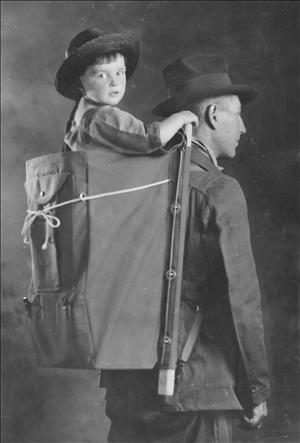On July 31, 1922, a patent application drawn up by Seattle attorney Richard J. Cook (1881?-1946) is filed with the U.S. Patent Office in an effort to establish legal protection for an invention by Bremerton entrepreneur Lloyd F. Nelson (1894?-1986). Nelson's uniquely designed "Trapper Nelson's Indian Pack Board" will meet with great commercial success and ultimately be acknowledged as the first-ever mass-produced external-frame pack.
Sturdy, Reliable, and Unique
Understandably inspired by the considerable pain and discomfort he experienced while hiking with a borrowed Inuit-made sticks-and-sealskin backpack while visiting Alaska in 1920, Bremerton's Lloyd F. Nelson began pondering how to design and make a new and different kind of pack than the all-cloth (or leather) rucksacks that were then available back home and popular among hunters and backwoods fishermen. His thoughts and subsequent experiments led to a type of rucksack that had not previously existed.
The central conceptual breakthrough was to create a stabilizing wooden pack-frame (or "pack board") upon which would be attached a canvas jacket (to cushion the wearer's back) and a canvas sack (to contain a hiker's supplies and belongings) that was attached to the frame with long steel pins to allow for easy detachability (for cleaning). The whole was held close to the hiker's body with two canvas shoulder-straps. In sum, the thing was sturdy, reliable, and unique to the marketplace.
Nelson hired Richard J. Cook -- an attorney noted for having been the very first tenant in Seattle's famed Smith Tower (506 Second Avenue, Suites 2004-2005) and once described in The Seattle Times as a "well known ... hunter and fisherman" ("Funeral for R.J. Cook ... ") -- who filed a patent application with the United States Patent Office on July 31, 1922. Slightly more than two years later, Nelson was granted U.S. Patent No. 1,505,661 on August 19, 1924. He then began production of the pack by hiring various townsfolk in Bremerton to make pack components and assemble them.
But initially sales were rather slow because, at the time of the Trapper Nelson invention, wilderness hiking had not quite yet become a widely popular outdoor activity for mainstream Americans. The pack was geared toward sportsmen, U.S. Forest Service firefighters, and then Department of the Interior and U.S. Geological Survey teams, and eventually military personnel. But as the 1920s slipped into the 1930s -- and after Nelson had sold his business to Seattle's Trager Manufacturing Co. (which much later became Trager USA, LLC in Monroe, Snohomish County) -- the Boy Scouts of America discovered the positive attributes of the "Trapper Nelson." In time the general public's fondness for nature, hiking, and camping increased exponentially. Today Lloyd F. Nelson is considered a father of the modern outdoor-gear industry.

